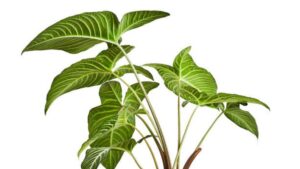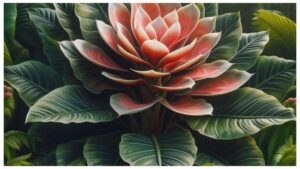Florida Beauty Philodendron, also known as Philodendron bipinnatifidum ‘Florida Beauty,’ is a captivating tropical plant admired for its lush foliage and vibrant colors. This content serves as a comprehensive guide to understanding and cultivating this beautiful species.
Origin and History
Origins:
Florida Beauty Philodendron originates from the lush rainforests of South America, particularly Brazil and Paraguay. Its natural habitat provides insights into its preferred growing conditions, making it easier to replicate in indoor settings.

Historical Significance:
The history of Florida Beauty Philodendron intertwines with humanity’s fascination with botanical diversity. Indigenous peoples of South America have long revered Philodendron species for their medicinal and cultural significance. Over time, these plants gained popularity worldwide, finding their way into homes, gardens, and botanical collections.
Physical Description
Leaf Shape and Size:
The leaves of Florida Beauty Philodendron are characterized by their unique shape and size. Each leaf consists of multiple lobes, giving it a distinctively tropical appearance. The size of the leaves can vary, with mature plants boasting leaves up to 3 feet in length.

Coloration:
One of the most striking features of Florida Beauty Philodendron is its vibrant coloration. The leaves display shades of deep green, bronze, and burgundy, creating a visually captivating display. The colors intensify under bright light, adding to the plant’s allure.
Cultivation and Care Tips
Light Requirements
Proper lighting is crucial for the health and growth of Florida Beauty Philodendron. While it thrives in bright, indirect light, direct sunlight can lead to leaf scorching. Position your plant near east or west-facing windows where it can receive filtered sunlight throughout the day. If natural light is limited, consider supplementing with artificial grow lights to ensure adequate brightness.
Watering Schedule
Maintaining a consistent watering schedule is key to preventing both underwatering and overwatering. Allow the top inch of soil to dry out between waterings, ensuring that the roots have access to moisture without becoming waterlogged. Water thoroughly until excess water drains from the bottom of the pot, and empty saucers to prevent water from pooling around the roots.
Soil Conditions
Florida Beauty Philodendron thrives in well-draining, aerated soil that retains moisture without becoming waterlogged. A high-quality potting mix enriched with organic matter, such as peat moss or compost, provides the ideal growing medium. Consider adding perlite or vermiculite to improve soil structure and enhance drainage.
Temperature and Humidity Needs
Maintaining optimal temperature and humidity levels mimicking its native tropical habitat is essential for the health and vitality of Florida Beauty Philodendron. Keep temperatures between 65-85°F (18-29°C) and humidity levels above 60%. Increase humidity by misting the leaves regularly or placing a humidifier nearby, especially during dry winter months or in air-conditioned environments.

Propagation Techniques
Stem Cuttings
Stem cuttings are one of the most common and straightforward methods of propagating Florida Beauty Philodendron. Follow these steps to propagate your plant successfully:
- Select a Healthy Stem: Choose a stem with at least two nodes, ensuring it is free from any signs of damage or disease.
- Prepare the Cutting: Use sharp, sterilized scissors or pruning shears to take a cutting just below a node. Remove any lower leaves to expose the nodes.
- Rooting Medium: Place the cutting in a container filled with water or moist potting mix. Ensure that the nodes are submerged in water or in contact with the soil to encourage root development.
- Provide Optimal Conditions: Place the cutting in a warm, bright location away from direct sunlight. Maintain consistent moisture levels in the rooting medium, ensuring it remains damp but not waterlogged.
- Monitor Growth: Over the following weeks, monitor the cutting for signs of root growth. Once roots have formed, you can transplant the new plant into a separate pot filled with well-draining potting mix.
Air Layering
Air layering is another propagation method that allows you to create new plants from existing stems. Follow these steps to air layer your Florida Beauty Philodendron:
- Select a Stem: Choose a healthy stem with multiple nodes and identify a section where you want to create a new plant.
- Make an Incision: Using a sharp knife, make a small incision just below a node. Make sure the cut is deep enough to penetrate the outer layer of the stem.
- Apply Rooting Hormone: Apply a small amount of rooting hormone to the incision site to encourage root development.
- Wrap with Moist Medium: Wrap the incision site with moist sphagnum moss, ensuring it covers the cut completely. Secure the moss in place with plastic wrap or twine.
- Provide Support: To keep the moss in place and maintain moisture, wrap the entire area with aluminum foil or plastic wrap.
- Wait for Roots to Form: Over the next few weeks, monitor the air layering site for signs of root growth. Once roots have developed, you can carefully remove the new plant from the parent stem and pot it in a separate container.
Propagation allows you to expand your Florida Beauty Philodendron collection and share the beauty of this plant with others. Whether you choose stem cuttings or air layering, both methods offer rewarding results and the satisfaction of nurturing new growth.
Growth Zone
The “Growth Zone” refers to the optimal conditions in which Florida Beauty Philodendron thrives and exhibits vigorous growth. Understanding your plant’s growth zone is essential for providing the ideal environment to promote healthy development. This encompasses factors such as light intensity, temperature, humidity levels, and soil quality. By creating a conducive growth zone tailored to the specific needs of your Florida Beauty Philodendron, you can ensure robust growth, vibrant foliage, and overall plant health.
Common Pests and Diseases
Florida Beauty Philodendron, like many houseplants, is susceptible to a variety of pests and diseases. Being aware of these potential issues and taking proactive measures can help keep your plant healthy and thriving.
Pests:
- Aphids: These small, sap-sucking insects can gather on the undersides of leaves, causing yellowing, distortion, and stunted growth. Control aphids by spraying the affected foliage with a mixture of water and insecticidal soap or neem oil.
- Spider Mites: These tiny arachnids thrive in dry, dusty conditions and can cause stippling, webbing, and leaf discoloration. Increase humidity levels to discourage spider mite infestations and use insecticidal soap or neem oil to control their population.
- Mealybugs: Mealybugs are white, cottony insects that feed on plant sap, causing leaf yellowing and distortion. Remove mealybugs manually with a cotton swab dipped in rubbing alcohol or treat with insecticidal soap.
Diseases:
- Root Rot: Overwatering and poorly draining soil can lead to root rot, a fungal disease that causes roots to decay. Prevent root rot by allowing the soil to dry out between waterings and ensuring proper drainage. If root rot occurs, remove the affected roots and repot the plant in fresh soil.
- Leaf Spot: Leaf spot is a fungal disease characterized by dark, water-soaked lesions on the foliage. Improve air circulation around the plant and avoid overhead watering to reduce the risk of leaf spot. Treat infected plants with a fungicide labeled for use on ornamental plants.
- Powdery Mildew: Powdery mildew manifests as a white, powdery coating on plant leaves and stems.. Increase air circulation and reduce humidity levels to prevent powdery mildew. Treat affected plants with a fungicide labeled for powdery mildew control.
Regular inspection and prompt intervention are essential for managing pest and disease issues effectively. By monitoring your Florida Beauty Philodendron closely and addressing any problems promptly, you can maintain its health and vitality for years to come.
Benefits of Growing Florida Beauty Philodendron
Beyond its aesthetic appeal, Florida Beauty Philodendron offers numerous benefits to both your home environment and your well-being. Here are some of the advantages of adding this beautiful plant to your indoor space:
- Air Purification: Like many other houseplants, Florida Beauty Philodendron helps improve indoor air quality by filtering out harmful toxins such as formaldehyde, benzene, and xylene. This natural air purification process promotes a healthier living environment for you and your family.
- Stress Reduction: Surrounding yourself with lush greenery, such as Florida Beauty Philodendron, can have a calming and stress-relieving effect. Studies have shown that interacting with indoor plants can lower blood pressure, reduce stress levels, and promote a sense of well-being.
- Enhanced Decor: With its vibrant foliage and striking appearance, Florida Beauty Philodendron adds a touch of elegance and sophistication to any room. Whether used as a focal point or as part of a larger botanical display, this plant can elevate the aesthetic appeal of your home decor.
- Low Maintenance: Florida Beauty Philodendron is relatively low-maintenance and easy to care for, making it an ideal choice for busy individuals or those new to plant care. With proper light, water, and occasional fertilization, this plant can thrive with minimal effort.
- Versatility: Florida Beauty Philodendron can adapt to a variety of indoor environments, including offices, living rooms, bedrooms, and kitchens. Its versatility allows you to incorporate it into different design schemes and layouts, whether as a hanging plant, tabletop centerpiece, or floor accent.
By growing Florida Beauty Philodendron in your home, you not only enhance the beauty of your indoor space but also reap the numerous health and wellness benefits it provides. Whether you’re a seasoned plant enthusiast or just starting your indoor gardening journey, this tropical beauty is sure to delight and inspire.
Popular Varieties
While Florida Beauty Philodendron, also known as Philodendron bipinnatifidum ‘Florida Beauty,’ is a beloved choice among plant enthusiasts, there are several other varieties of Philodendron worth exploring. Each variety offers its unique characteristics and charm, adding diversity to your indoor garden. Here are a few popular varieties to consider:
- Philodendron erubescens ‘Red Emerald’: This variety of Philodendron is prized for its stunning red stems and lush green foliage. The leaves have a glossy texture and feature distinctive red veins, adding visual interest to any space. Philodendron erubescens ‘Red Emerald’ is a vigorous grower and can quickly fill out a room with its vibrant presence.
- Philodendron hederaceum ‘Heartleaf’: As the name suggests, this variety of Philodendron features heart-shaped leaves that cascade gracefully from trailing stems. Philodendron hederaceum ‘Heartleaf’ is an excellent choice for hanging baskets or as a trailing accent in plant arrangements. It thrives in bright, indirect light and requires regular watering to keep the soil consistently moist.
- Philodendron scandens ‘Brasil’: Characterized by its variegated foliage, Philodendron scandens ‘Brasil’ boasts leaves adorned with shades of green and yellow. This variety adds a pop of color to any space and is ideal for brightening up dull corners or shelves. Philodendron scandens ‘Brasil’ is relatively easy to care for and can tolerate a range of lighting conditions, making it suitable for beginners.



These are just a few examples of the many Philodendron varieties available to plant enthusiasts. Whether you’re drawn to the bold colors of ‘Red Emerald,’ the classic elegance of ‘Heartleaf,’ or the vibrant variegation of ‘Brasil,’ there’s a Philodendron variety to suit every taste and preference.
Creative Uses in Interior Design
Florida Beauty Philodendron’s versatility makes it an excellent choice for various interior design applications. Whether you’re looking to add a pop of color to a dull corner or create a lush green oasis in your home, this tropical plant offers endless possibilities. Here are some creative ways to incorporate Florida Beauty Philodendron into your interior design:
- Hanging Baskets: Hang Florida Beauty Philodendron in decorative baskets or macramé hangers to add visual interest to walls or ceilings. This creates a cascading effect, allowing the foliage to spill over and soften the surrounding space.
- Vertical Gardens: Create a stunning vertical garden by mounting Florida Beauty Philodendron on a living wall or vertical planter. This not only adds a touch of greenery but also helps purify the air and create a more inviting atmosphere.
- Terrariums: Plant Florida Beauty Philodendron in glass terrariums or containers to create miniature indoor gardens. Combine it with other plants, moss, and decorative elements to design a captivating display that brings a slice of the rainforest into your home.
- Statement Pieces: Use Florida Beauty Philodendron as standalone statement pieces to draw attention to specific areas of your home. Place it on a pedestal or plant stand to elevate its presence and create a focal point in any room.
- Botanical Arrangements: Incorporate Florida Beauty Philodendron into botanical arrangements alongside other plants and decorative elements. Mix different textures, heights, and colors to create visually dynamic displays that add life and vibrancy to your space.
By thinking creatively and experimenting with different design ideas, you can harness the beauty and versatility of Florida Beauty Philodendron to transform your home into a green oasis. Whether you’re aiming for a modern, minimalist aesthetic or a cozy, eclectic vibe, this tropical plant is sure to enhance the ambiance of any room.
Conclusion
In this guide, we’ve explored the fascinating world of Florida Beauty Philodendron, a stunning tropical plant prized for its lush foliage and vibrant colors. From its origins in the rainforests of South America to its versatile use in interior design, Florida Beauty Philodendron offers a wealth of benefits for both your home environment and your well-being.
FAQs (Frequently Asked Questions)
Is Florida Beauty Philodendron suitable for beginners?
Absolutely! Florida Beauty Philodendron is a relatively low-maintenance plant that is well-suited for beginners. With proper care and attention to its basic needs, such as light, water, and soil conditions, beginners can enjoy growing this beautiful tropical plant with ease.
How often should I fertilize my Florida Beauty Philodendron?
During the growing season, typically spring and summer, fertilize your Florida Beauty Philodendron once a month with a balanced liquid fertilizer diluted to half strength. Reduce fertilization frequency during fall and winter when the plant’s growth slows down.
Can I grow Florida Beauty Philodendron outdoors?
While Florida Beauty Philodendron thrives indoors in a controlled environment, it can also be grown outdoors in tropical or subtropical regions with warm, humid climates. Ensure it receives bright, indirect light and protection from harsh sun and strong winds.
What should I do if my Florida Beauty Philodendron’s leaves turn yellow?
Yellowing leaves may indicate different problems, such as overwatering, underwatering, or nutrient deficiencies. Evaluate your plant’s watering schedule and adjust as needed. Ensure proper drainage and consider fertilizing with a balanced fertilizer to address any nutrient deficiencies.
Is Florida Beauty Philodendron safe for pets?
While Florida Beauty Philodendron is not considered highly toxic, it can cause mild gastrointestinal upset if ingested by pets. To ensure the safety of your furry friends, keep the plant out of their reach or opt for pet-safe alternatives if you have curious pets in your home.
